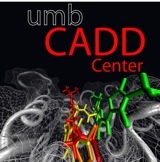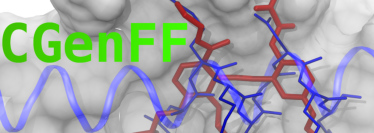
CGenFF
This page was originally developed by Kenno Vanommeslaeghe here.
University of Maryland, Baltimore
Baltimore, MD 21201
USA

|
CGenFFThis page was originally developed by Kenno Vanommeslaeghe here. |
University of Maryland, Baltimore |

sed -i 's/Ar/ar/' *.mol2
sed -i 's/Ar/ar/' *.mol2
sed -i 's/_\+ //' *.mol2
chmod 755 mol2crd (this needs to be run only once)charmm resi=molecule -i minimize.inp -o molecule.out
regroup.awk molecule.str > molecule_regrouped.str
...
structure system-xplor.psf
paraTypeCharmm on
parameters par_all36_prot.prm
mergeCrossterms yes
parameters par_all36_lipid.prm
parameters par_all36_carb.prm
parameters par_all36_cgenff.prm
parameters molecule.str
parameters toppar_water_ions_namd.str
...